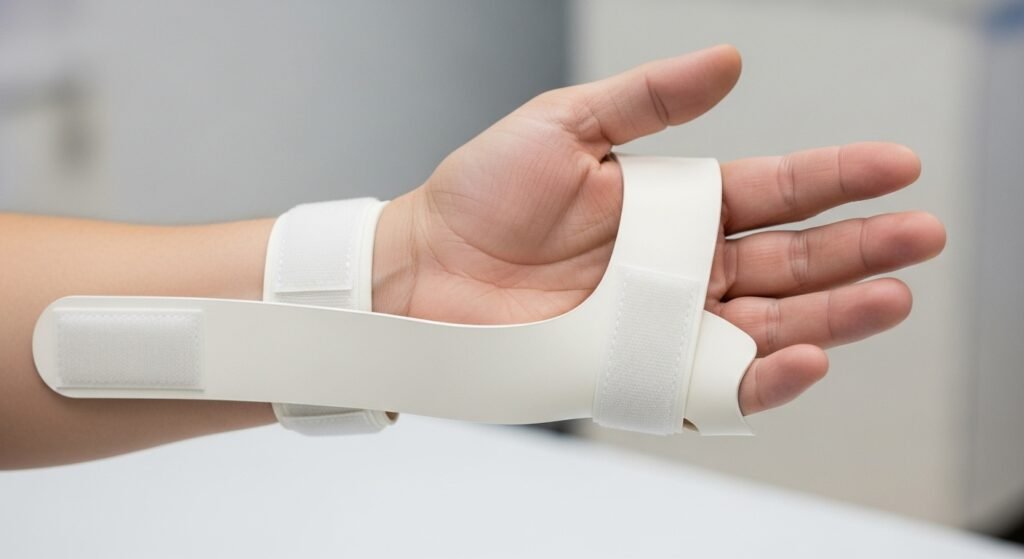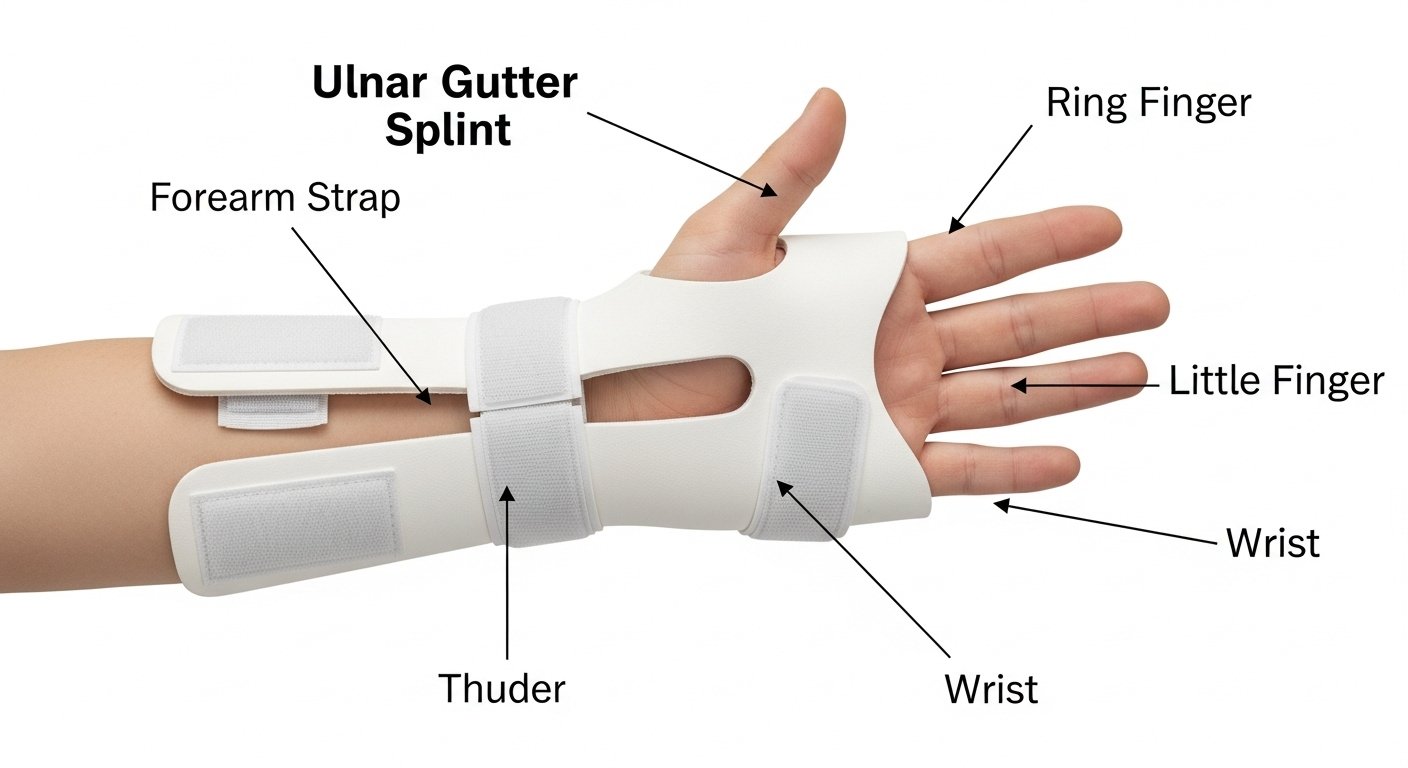Introduction
Have you ever hurt your pinky finger or the side of your hand near it? If yes, then you might’ve seen or worn something called an ulnar gutter splint. It may sound like a tricky medical tool, but it’s actually a simple and helpful device. An ulnar gutter splint is used to support and protect the little finger (the pinky) and the ring finger, as well as the bones in the hand connected to them. Doctors often use it when these parts get broken, sprained, or strained. Instead of letting the injury move around, the splint keeps everything still so it can heal the right way. In this article, we’ll go over what an ulnar gutter splint is, when it’s used, how it works, how to wear it properly, and much more. If you or someone you know needs hand or finger support, this guide will help you understand everything in the easiest way possible.
What Exactly Is an Ulnar Gutter Splint?
An ulnar gutter splint is a type of soft or hard brace that wraps around the ring and pinky fingers and supports the ulnar side of the hand (this is the side where your pinky is). The splint usually extends from the fingertips to around the middle of the forearm. Its main job is to keep your hand and fingers in a straight, safe position while they heal from injury. It is often made using plastic, fiberglass, foam, or even padded metal. Doctors or orthopedic specialists usually apply it using soft padding and bandages so it’s both firm and comfortable. The shape of the splint “cradles” your fingers and hand, which is why it’s called a “gutter” splint.
When Is an Ulnar Gutter Splint Used?
Doctors use an ulnar gutter splint when someone has an injury on the pinky side of the hand or lower forearm. This tool is commonly used for broken fingers—especially the fourth and fifth metacarpals (the bones in the hand near the pinky and ring finger). It’s also helpful for dislocated joints, tendon injuries, or sprains in the same area. If you play sports like basketball, baseball, or martial arts, you might need it after a tough contact or an awkward fall. It helps hold things in place so they don’t move and get worse. It’s also used after finger surgeries to keep the healing process safe and steady.
What Injuries Commonly Need an Ulnar Gutter Splint?
The most common injury that needs an ulnar gutter splint is a “boxer’s fracture.” This happens when someone punches a hard object and breaks the bone below their pinky. But there are other reasons, too. You might need this splint if you fall on your hand, jam your finger playing ball, or hurt your tendons. Ulnar gutter splints are often used for fractures or soft tissue injuries in these fingers because it’s a less invasive way to treat minor and mid-level damage. Sometimes, doctors use them after surgeries just to make sure nothing shifts while healing.
How Does an Ulnar Gutter Splint Help With Healing?
Healing takes time and rest—and that’s exactly what an ulnar gutter splint provides. The splint helps by stopping your fingers from bending and your hand from twisting. When you keep your hand still, there’s less shock and pressure on the injured area. This gives bones, ligaments, or tendons a chance to repair naturally. Think of it like a tiny bed for your hand that holds each injured part in the right spot while your body does its job. The splint also protects your hand from sudden bumps or bumps during daily activities. By using a splint, you can heal faster and avoid more serious damage.
How to Properly Wear an Ulnar Gutter Splint
Wearing an ulnar gutter splint the right way is super important for it to work well. Most people get their splint fitted by a doctor or nurse to make sure it supports the injured spot correctly. The pinky and ring fingers are kept slightly bent—this is called the “safe position” or “functional position.” Your wrist usually stays straight, and the splint wraps from your fingertips down the hand and along the side of the forearm. Padding and tape or bandage help hold it in place. It should feel snug but not painful. If it’s too tight or causes numbness, you should tell your doctor right away.
What Materials Are Ulnar Gutter Splints Made Of?
An ulnar gutter splint can be made from different kinds of materials depending on the need and doctor’s choice. Some common materials include fiberglass and thermoplastics, which are hard and strong. These splints are often molded to fit your hand perfectly. Other splints use foam or soft fabric with a plastic strip inside for semi-rigid support. Hospitals usually use plaster when first applying a splint, especially after an injury with swelling. Once the swelling goes down, they might replace it with a lighter type. All materials are safe and made to keep your hand comfortable while healing.
Can You Shower or Sleep With an Ulnar Gutter Splint?

Many people wonder if it’s okay to sleep or shower with an ulnar gutter splint on. For sleeping, the answer is usually yes. You should wear it while sleeping to keep your hand protected. Try to rest your hand on a pillow to avoid stiffness. For showering, the answer is trickier. Most splints are not waterproof unless specially made that way. Getting it wet can ruin the materials and cause skin irritation. To protect it during a shower, wrap it with a clean plastic bag and use tape or rubber bands to seal it at the top. Always check with your doctor to be sure.
How Long Do You Have to Wear an Ulnar Gutter Splint?
The amount of time you need to wear an ulnar gutter splint depends on your injury. For simple fractures, you might wear it for 2 to 3 weeks. For more serious injuries or sprains, it could be 4 to 6 weeks, sometimes longer if healing is slow. Your doctor will check your progress and decide when it’s okay to stop wearing it. Don’t take it off early, even if you feel better, because the bones or tendons could still need rest. In some cases, after the splint comes off, you may get hand therapy to help you move your fingers again smoothly and safely.
Can You Move Your Fingers While Wearing an Ulnar Gutter Splint?
While you are wearing an ulnar gutter splint, your pinky and ring fingers are held in place, so they shouldn’t move. However, your thumb and the other two fingers may still be able to move normally. This gives you some hand function but still protects the part that needs healing. Your doctor may ask you to wiggle the free fingers to keep your circulation healthy. If you feel tingling, numbness, or swelling, you should raise your hand above heart level and tell your doctor. Limiting movement in the hurt fingers is key to full healing, so follow your healthcare provider’s advice carefully.
How to Take Care of the Splint and Your Skin
Taking care of both your ulnar gutter splint and the skin underneath is important for comfort and health. First, never try to remove or adjust the splint unless your doctor says it’s okay. If the splint gets loose, dirty, or damaged, let your medical team know. Clean your visible skin daily, and use a soft, dry towel to gently pat around the bandages. Keep the splint dry and avoid putting weight or pressure on it. If your skin becomes itchy, red, or sore, contact your doctor. Always wear the splint the way your instructions say to prevent problems and keep healing on track.
What to Expect During Recovery
Recovery while using an ulnar gutter splint can feel slow, but healing is happening behind the scenes. You may feel stiffness or soreness at first, but that’s normal. Keeping your hand elevated for the first few days helps reduce swelling. After the splint is removed, your hand may feel weak or stiff—don’t worry. Your doctor may suggest gentle exercises or therapy to regain motion and strength. The key is patience. Most people recover well if they follow their treatment plan and don’t rush to return to intense hand use. Listen to your body, ask questions, and give it the rest it needs.
When to Call the Doctor
While wearing an ulnar gutter splint, keep an eye on how your hand feels. Call your doctor if you notice signs like severe pain, numbness, pins-and-needles feelings, or unusual swelling. Also, if you get a fever or your hand feels warm and red, it could mean infection. Another sign to report is if your splint becomes too loose or tight. These changes can prevent healing or worsen your injury. Your doctor might schedule follow-up visits so they can check your progress and make changes if needed. Don’t try to fix things on your own—it’s always safer to talk to a professional.
FAQs
1. Can I play sports while wearing an ulnar gutter splint?
No. You should avoid sports and heavy activities until your doctor says it’s safe to return.
2. Is wearing an ulnar gutter splint painful?
It may feel uncomfortable at first, but it should not cause pain. If it does, see your doctor.
3. Can I drive with an ulnar gutter splint?
Driving is usually not recommended, especially if your dominant hand is affected. Always ask your doctor.
4. Will I need physical therapy after using the splint?
Sometimes, yes. Hand therapy may help restore strength and movement if you were in a splint for weeks.
5. How do I know if my finger is healing inside the splint?
Most doctors schedule follow-up visits and possibly X-rays to check on the healing progress.
6. Can I remove the splint myself at home?
No. Always wait for a medical professional to remove or make changes to the splint.
Conclusion
The ulnar gutter splint may seem simple, but it plays a big role in healing hand and finger injuries safely. It helps protect broken bones, tendons, or joints by keeping them still and supported. Whether you’ve hurt your pinky in a fall, sports play, or accident, this splint gives your hand the rest it needs. It’s easy to apply, comfortable to wear when fitted correctly, and backed by medical experience. Just remember: follow your doctor’s advice, take care of your splint, and give your fingers time to heal. If you or someone you know ever needs hand support, remember how powerful this little splint can be. Stay safe, take care of your hands, and share this guide with anyone who needs reliable info on healing the right way.






